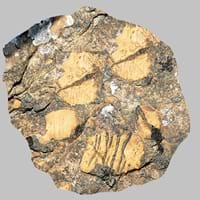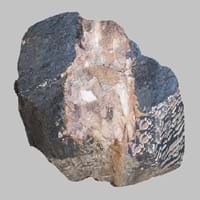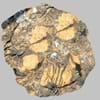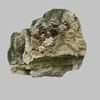Diamictite and Claystone
Definition
Definition
Diamictite is a sedimentary rock that consists of non-sorted to poorly sorted terrigenous sediment containing particles that range in size from clay to boulders, suspended in a matrix of mudstone or sandstone
Claystone is a fine-grained, dark gray to pink sedimentary rock which mainly consists of compacted and hardened clay
History
Origin
Southern Mongolia
Unknown
Discoverer
Unknown
Unknown
Etymology
From Greek dia through and meiktós or mixed
From English clay and stone as the rock contains more amount of clay
Class
Sedimentary Rocks
Sedimentary Rocks
Sub-Class
Durable Rock, Soft Rock
Durable Rock, Medium Hardness Rock
Family
Group
Not Applicable
Not Applicable
Other Categories
Coarse Grained Rock, Opaque Rock
Fine Grained Rock, Opaque Rock
Texture
Texture
Clastic
Clastic
Color
Brown, Buff
Black, Blue, Brown, Green, Grey, Orange, Red, White, Yellow
Maintenance
Less
More
Durability
Durable
Durable
Water Resistant
No
Yes
Scratch Resistant
No
Yes
Stain Resistant
No
No
Wind Resistant
No
No
Acid Resistant
No
No
Appearance
Banded
Rough and Dull
Uses
Architecture
Interior Uses
Decorative Aggregates, Interior Decoration
Decorative Aggregates, Entryways, Floor Tiles, Homes, Interior Decoration
Exterior Uses
As Building Stone, Paving Stone
As Facing Stone, Roof Tiles
Other Architectural Uses
Curbing
Curbing
Industry
Construction Industry
As Dimension Stone, Construction Aggregate, for Road Aggregate, Landscaping, Roadstone
As a Sintering Agent in Steel Industry to process Iron Ore, Cement Manufacture, Construction Aggregate, for Road Aggregate, Making natural cement, Raw material for the manufacture of mortar
Medical Industry
Not Yet Used
Not Yet Used
Antiquity Uses
Artifacts
Artifacts, Sculpture, Small Figurines
Other Uses
Commercial Uses
Commemorative Tablets, Creating Artwork, Production of Lime
Pottery
Types
Types
Bedded Diamictite and Laminated Diamictite
Not Available
Features
Host Rock for Lead, Is one of the oldest rock
Available in Lots of Colors and Patterns, Smooth to touch, Very fine grained rock
Archaeological Significance
Monuments
Not Yet Used
Not Yet Used
Famous Monuments
Not Applicable
Not Applicable
Sculpture
Not Yet Used
Used
Famous Sculptures
Not Applicable
Data Not Available
Pictographs
Used
Used
Petroglyphs
Used
Used
Figurines
Not Yet Used
Used
Fossils
Present
Present
Formation
Formation
Diamictite is unevenly sorted terrigenous, non-calcareous sedimentary rock which forms due to weathering of mudstone and sandstone.
Claystone is generally quite soft, but can be hard and brittle. It forms due to weathering of mudstone.
Composition
Mineral Content
Calcite, Clay, Feldspar, Micas, Quartz
Biotite, Chlorite, Feldspar, Micas, Muscovite or Illite, Plagioclase, Pyrite, Quartz
Compound Content
Not Available
Aluminium Oxide, Ca, NaCl, CaO, Iron(III) Oxide, MgO, Silicon Dioxide
Transformation
Metamorphism
No
No
Types of Metamorphism
Not Applicable
Not Applicable
Weathering
Yes
Yes
Types of Weathering
Biological Weathering, Chemical Weathering
Biological Weathering, Chemical Weathering, Mechanical Weathering
Erosion
Yes
Yes
Types of Erosion
Chemical Erosion, Coastal Erosion, Water Erosion
Coastal Erosion, Water Erosion
Properties
Physical Properties
Hardness
2-3
3.5-4
Grain Size
Coarse Grained
Fine Grained
Fracture
Conchoidal to Uneven
Not Available
Streak
Light to dark brown
White
Porosity
Highly Porous
Very Less Porous
Luster
Grainy, Pearly and Vitreous
Dull
Cleavage
Not Available
Perfect
Toughness
Not Available
2.6
Specific Gravity
4.3-5.0
0
Transparency
Opaque
Opaque
Density
2.2-2.35 g/cm3
2-2.9 g/cm3
Thermal Properties
Specific Heat Capacity
0.75 kJ/Kg K
18
0.92 kJ/Kg K
10
Resistance
Heat Resistant, Impact Resistant
Heat Resistant, Impact Resistant
Reserves
Deposits in Eastern Continents
Asia
China, India, Kazakhstan, Mongolia, Russia
Bangladesh, China, India, Russia
Africa
Namibia, Nigeria, South Africa
Ethiopia, Kenya, Morocco, South Africa, Tanzania
Europe
Austria, Denmark, Germany, Great Britain, Netherlands, Norway, Poland, Sweden, Switzerland, United Kingdom
Austria, France, Germany, Greece, Italy, Romania, Scotland, Spain, Switzerland
Others
Not Yet Found
Not Yet Found
Deposits in Western Continents
North America
Canada, USA
Canada, Panama, USA
South America
Brazil, Venezuela
Bolivia, Chile, Colombia, Ecuador, Peru, Venezuela
Deposits in Oceania Continent
Australia
New South Wales, New Zealand
New South Wales, New Zealand, Queensland, Victoria, Western Australia
All about Diamictite and Claystone Properties
Know all about Diamictite and Claystone properties here. All properties of rocks are important as they define the type of rock and its application. Diamictite and Claystone belong to Sedimentary Rocks.Texture of Diamictite is Clastic whereas that of Claystone is Clastic. Diamictite appears Banded and Claystone appears Rough and Dull. The luster of Diamictite is grainy, pearly and vitreous while that of Claystone is dull. Diamictite is available in brown, buff colors whereas Claystone is available in black, blue, brown, green, grey, orange, red, white, yellow colors. The commercial uses of Diamictite are commemorative tablets, creating artwork, production of lime and that of Claystone are pottery.
|
||
|
||
|










